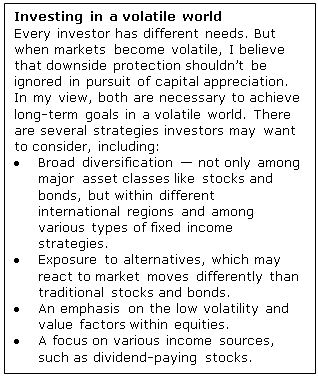by Kristina Hooper, Chief Investment Strategist, Invesco Ltd., Invesco Canada
Last week brought several developments that underscore my “3-D” view of critical factors that are impacting markets. Disruption, divergence and debt were all evident within recent headlines.
1. Disruption
Disruption can take a few different forms, but much of what we are facing now can be classified as either geopolitical or monetary-policy disruption.
Geopolitical disruption. Populism is still alive and well, as evidenced by the results of Austria’s election this past weekend. Despite all the problems facing the U.K. in its efforts to separate from the European Union (EU), Austrian voters took a more skeptical stance on the EU – the nationalist Austrian People’s Party garnered the most votes and will likely form a coalition government with another right-wing political party. Austria joins its neighbour Hungary, which also has a populist president.
Austria’s election results come as Catalonia is still attempting to negotiate its independence from Spain. Catalonia is eager to join the EU in its own right but may be hampered by the Prodi doctrine, which is intended to penalize any region that breaks away from a member state by delaying its entrance into the EU. If Catalonia cannot immediately join the EU and must instead pursue the lengthy application process for non-members, it will be in dire straits without key trading partners for a lengthy period of time. Needless to say, more populist movements – nationalist and more regionally focused – could threaten the stability of the EU.
In addition, there is now significant uncertainty around the Iran nuclear deal, which is now in serious jeopardy with U.S. President Donald Trump’s decision last week to decertify Iran. This does not mean the deal is over, but it does suggest that it has a good chance of being terminated. The conservative think tank, the Cato Institute, is opposed to ending this agreement, acknowledging that while it hasn’t solved all the problems with the U.S.-Iran relationship, it did achieve its goal of preventing nuclear proliferation. What’s more, the termination of the agreement with Iran could have implications for any strategy in dealing with North Korea. With few options on the table for halting North Korea’s attempts at nuclear proliferation, an Iran-like deal was considered one of only a few viable ways to contain North Korea’s nuclear ambitions; if the deal is terminated, that would most likely eliminate that option.
In addition, North American Free Trade Agreement (NAFTA) negotiations are continuing with substantial rancor. The U.S. is making demands – particularly around “rules of origin” requirements – that seem destined to result in no trade agreement because they are strongly opposed by both Canada and Mexico. The U.S. Chamber of Commerce is supportive of updating and modernizing NAFTA but is opposed to terminating the agreement, which seems to be a likely scenario given the state of current negotiations. I concur with the Chamber of Commerce, which posits that ending NAFTA could produce negative results for the U.S. economy. In particular, the chamber has argued that NAFTA supports nearly 14 million American jobs, including almost 5 million jobs specifically created by the agreement. Hit particularly hard would be the agricultural industry in the U.S., which has seen exports to Canada expand to three times the size they were before NAFTA and exports to Mexico expand to five times the size they were prior to the agreement.
Monetary policy disruption. The search for a new U.S. Federal Reserve (Fed) chair continues, with President Trump interviewing candidates last week. There has been speculation that Fed Governor Jerome Powell is currently in the lead, followed by former Fed Governor Kevin Warsh, current Fed Chair Janet Yellen and Stanford University economist John Taylor. Further down in the odds are National Economic Council Director Gary Cohn and Minneapolis Fed President Neel Kashkari. This is a critically important choice given that the Fed is in uncharted territory, beginning the normalization of its balance sheet at the same time it is slowly tightening its monetary policy. Depending on the view of its new leader, the Fed could go in a variety of different directions.
The frontrunner, Mr. Powell, is the candidate most likely to maintain the status quo, in my view, while Mr. Warsh has the potential to upset the proverbial apple cart given his vocal criticism of Fed policy in recent years. Mr. Warsh – who I believe has a better chance of being chosen by President Trump than the odds suggest – has deep convictions when it comes to monetary policy, which he has expressed in a number of written commentaries in recent years. Beyond favouring financial deregulation, he seems likely to pursue a more hawkish normalization process. For example, he has advocated lowering the Fed’s inflation target from 2% to 1%, which would hasten rate hikes. He is also unlikely to maintain a “data-dependent” monetary policy (which takes action based on what economic data tell us) given his apparent support for something akin to “trend spotting” (which allows for policy adjustment based on emerging trends). We will want to follow this process closely – this could be the most important job in the world right now as the Fed’s normalization process could create some disruption in the markets.
I do think it’s worth adding that Mr. Kashkari, while a dark-horse candidate, could be a positive choice. Not only is he likely to be a relative dove when it comes to monetary policy (at a time when it probably makes sense to tread lightly), but, more important, his experience during the Global Financial Crisis as part of Treasury Secretary Hank Paulson’s team could be valuable in case there is another significant recession. His resumé alone could calm markets, in my view, just as former Fed Chair Ben Bernanke’s experience as an expert on the Great Depression helped calm markets a decade ago.
2. Divergence
The theme of divergence was also on display last week as the International Monetary Fund (IMF) revised its growth estimates for some major countries. The IMF recognized that “the global upswing in economic activity is strengthening,” and upwardly revised growth projections for Japan, China, the euro area and Russia. However, the IMF downwardly revised growth projections for the United Kingdom, India and the U.S., and identified potential risks to global growth. This is a reminder that even in an environment of global growth, there is a divergence in the growth prospects of different economies – as well as differences in regional valuations, by the way – which I believe illustrates the need for international diversification.
3. Debt and demographics
The U.S. tax reform proposal has been analyzed, with the Committee for a Responsible Federal Budget estimating that the legislation will add US$2.2 trillion to the federal deficit in the next 10 years – US$2.7 trillion if you factor in interest. This would only add to the Congressional Budget Office’s current projection that the U.S. national debt will increase from US$15 trillion now to US$25 trillion in 2027.
Japan is in a similar situation, as it has relied on fiscal stimulus to spur economic growth, even though it has added to the already-bloated federal debt; the snap elections in Japan next week are likely to reinforce this path. And, several European countries, including the Netherlands and Belgium, have embarked on tax cuts – with France likely to tackle the issue next. Dutch tax reform is focused on lowering the corporate tax rate and simplifying income tax brackets – not dissimilar to some of the proposals on the table in the U.S.
However, I would expect that deficit hawks in the U.S. may derail plans for the tax bill to be passed in its entirety, or anywhere near its entirety, given the costs involved. For example, the estate tax cut would add US$400 billion to the deficit over the next 10 years, with arguably little economic stimulus to show for it. We need to remember that all tax cuts are not created equally. Therefore, if we can see just some of the tax cuts come to fruition – those that have the greatest potential to have a positive impact on the economy – then that may be an optimal scenario.
Interestingly, the reason the IMF slightly downgraded its forecast for U.S. growth last week is that it no longer assumes that a tax reform bill will be passed. As the IMF explained, “The downward revision relative to the April WEO [World Economic Outlook] forecasts reflects a major correction in U.S. fiscal policy assumptions. Given the significant policy uncertainty, IMF staff’s macroeconomic forecast now uses a baseline assumption of unchanged policies, whereas the April 2017 WEO built in a fiscal stimulus from anticipated tax cuts.”
What does this mean for markets?
And that brings us to the current market environment. Many stock indices around the globe hit new highs last week, undoubtedly helped by improving global growth prospects as well as relatively accommodative monetary policy. In the U.S., stocks hit new highs while the CBOE Volatility Index (or VIX) remains low. And, valuations are much higher in the U.S. stock market than in other regions, suggesting greater vulnerability, especially since much of the positive sentiment surrounding U.S. stocks is arguably based on expectations about the administration’s legislative agenda – especially its tax reform plan – coming to fruition. As we mark the 30th anniversary of the stock market crash of 1987, should serve as a reminder that no matter how well the stock market is doing, we need to be vigilant.
*****
Diversification does not guarantee a profit or eliminate the risk of loss.
The CBOE Volatility Index® (VIX®) is a key measure of market expectations of near-term volatility conveyed by S&P 500 stock index option prices. VIX is the ticker symbol for the Chicago Board Options Exchange (CBOE) Volatility Index, which shows the market’s expectation of 30-day volatility.
Alternative products typically hold more nontraditional investments and employ more complex trading strategies, including hedging and leveraging through derivatives, short selling and opportunistic strategies that change with market conditions. Investors considering alternatives should be aware of their unique characteristics and additional risks from the strategies they use. Like all investments, performance will fluctuate. You can lose money.
In general, stock values fluctuate, sometimes widely, in response to activities specific to the company as well as general market, economic and political conditions.
Fixed income investments are subject to credit risk of the issuer and the effects of changing interest rates. Interest rate risk refers to the risk that bond prices generally fall as interest rates rise and vice versa. An issuer may be unable to meet interest and/or principal payments, thereby causing its instruments to decrease in value and lowering the issuer’s credit rating.
The risks of investing in securities of foreign issuers can include fluctuations in foreign currencies, political and economic instability, and foreign taxation issues.
Common stocks do not assure dividend payments. Dividends are paid only when declared by an issuer’s board of directors, and the amount of any dividend may vary over time.
The opinions referenced above are those of Kristina Hooper as of Oct. 16, 2017. These comments should not be construed as recommendations, but as an illustration of broader themes. Forward-looking statements are not guarantees of future results. They involve risks, uncertainties and assumptions; there can be no assurance that actual results will not differ materially from expectations.
Copyright © Invesco Canada
















